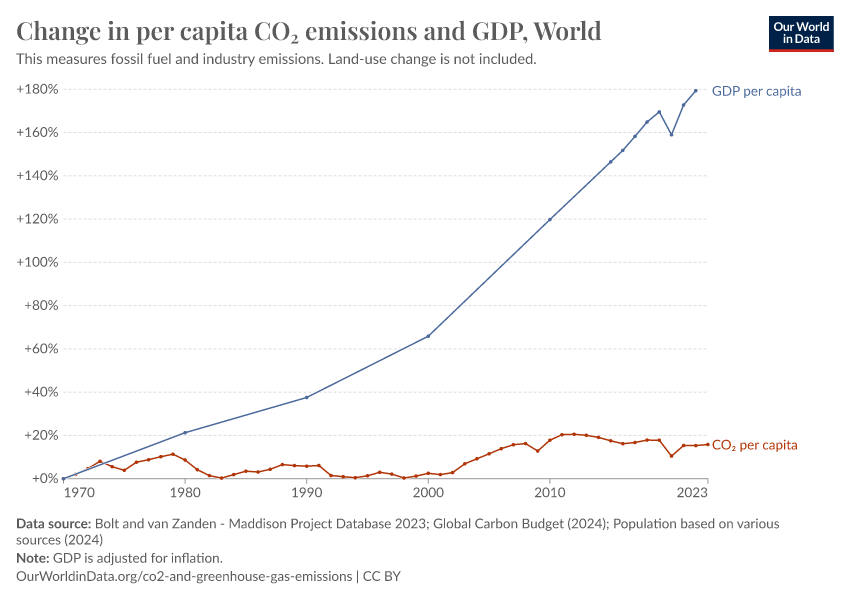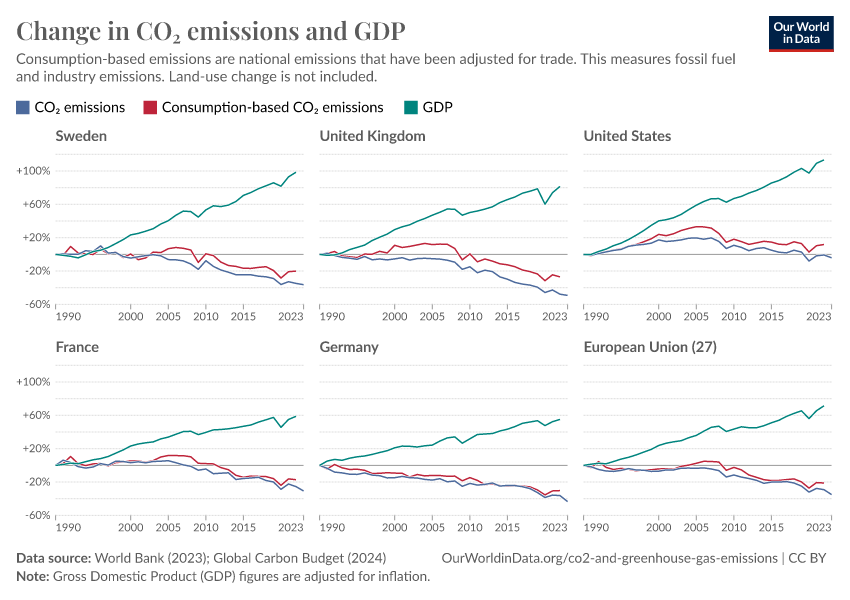Many countries have decoupled economic growth from CO2 emissions, even if we take offshored production into account
It is possible to reduce emissions while growing the economy. But this decoupling needs to happen faster.
Historically, CO2 emissions have been strongly correlated with how much money we have. This is particularly true for low-to-middle incomes. The richer we are, the more CO2 we emit. This is because we use more energy – which often comes from burning fossil fuels.
But this relationship no longer holds true at higher incomes. Many countries have managed to achieve economic growth while reducing emissions. They have decoupled the two.
Take the UK as an example. It is shown in the chart. This chart shows the change in GDP and annual CO2 emissions per capita since 1990. We see that the UK’s GDP has increased a lot over the last 30 years while its emissions have fallen. You can also see the data without per capita adjustments.

It’s not just the UK. Many other countries have achieved this decoupling. Using the “Edit countries and regions” button on the chart, you can see this for yourself. France, Germany, Sweden, Finland, Denmark, Italy, Czechia, and Romania are examples of countries where we see this.

This decoupling is even more pronounced over the past two decades, since the turn of the millennium.
Consumption-based emissions continued to rise in countries such as the US throughout the 1990s. But they have dropped a lot since 2005, alongside a rise in GDP. This is true for many more countries, which are shown in the static visualization below. Again, emissions are adjusted for trade.
There are two key reasons why emissions have fallen in these countries. First, some countries have managed to decouple energy use and economic growth. GDP has increased while total energy use has remained flat, or even fallen. But the second is the most important: countries are replacing fossil fuels with low-carbon energy. We can produce more energy, without the emissions that used to come with it.
It would be wrong to assume that this reduction in emissions in rich countries was only achieved by offshoring production overseas – by transferring emissions to manufacturing economies such as China and India. In the chart we see that consumption-based emissions – which adjust for emissions from goods that are imported or exported – have also fallen. Some emissions have been exported overseas, but this is not the only driver of this decline.
These countries show that economic growth is not incompatible with reducing emissions.
A key question is whether we can decarbonize fast enough, and across more countries. The continued decline in the cost of low-carbon technologies makes this acceleration more realistic every day.
Related charts
Cite this work
Our articles and data visualizations rely on work from many different people and organizations. When citing this article, please also cite the underlying data sources. This article can be cited as:
Hannah Ritchie (2021) - “Many countries have decoupled economic growth from CO2 emissions, even if we take offshored production into account” Published online at OurWorldinData.org. Retrieved from: 'https://archive.ourworldindata.org/20251220-152415/co2-gdp-decoupling.html' [Online Resource] (archived on December 20, 2025).BibTeX citation
@article{owid-co2-gdp-decoupling,
author = {Hannah Ritchie},
title = {Many countries have decoupled economic growth from CO2 emissions, even if we take offshored production into account},
journal = {Our World in Data},
year = {2021},
note = {https://archive.ourworldindata.org/20251220-152415/co2-gdp-decoupling.html}
}Reuse this work freely
All visualizations, data, and code produced by Our World in Data are completely open access under the Creative Commons BY license. You have the permission to use, distribute, and reproduce these in any medium, provided the source and authors are credited.
The data produced by third parties and made available by Our World in Data is subject to the license terms from the original third-party authors. We will always indicate the original source of the data in our documentation, so you should always check the license of any such third-party data before use and redistribution.
All of our charts can be embedded in any site.

